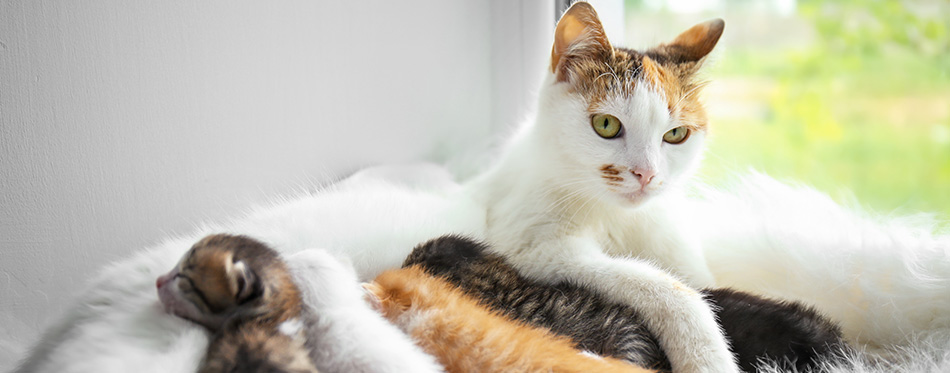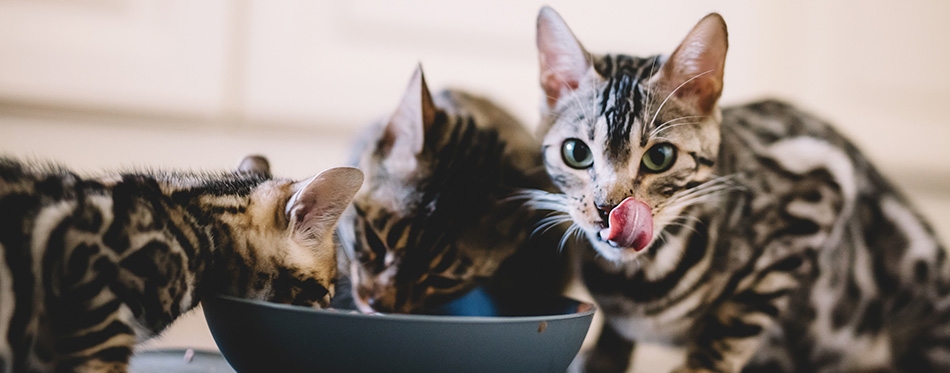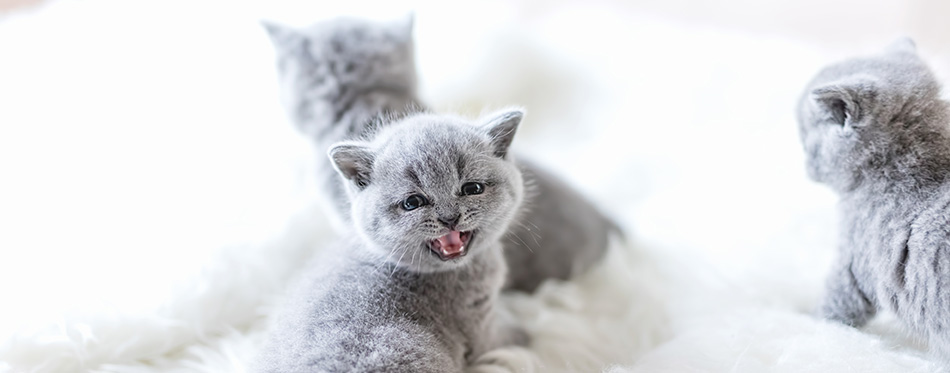Kitten care is nothing to sniff at – especially if you’re taking the place of the mother cat on a full-time basis. It takes a lot of time, energy, care, and conversing with your local veterinarian to keep those kittens happy and healthy. So, whether you’re rescuing young kittens or helping out the mother cat to ensure the best care, our guide will teach you everything you need to know about caring for newborn kittens until they’re old enough to be adopted.
Are you Supposed to Touch Newborn Kittens?
Kittens are beyond adorable, but if the mother cat has just given birth to her kittens, it’s generally advised to try not to intervene. So, only touch newborns if they’re in distress, not moving or breathing, or not suckling milk within the first two hours after birth. These are all signs that something could be wrong, and we’d always recommend a call to your local veterinarian if you’re worried about your kittens.
Touching a Newborn Kitten That Isn’t Suckling
As mentioned above, there are very few reasons to touch a kitten. The first reason to touch a kitten that has just been birthed by the mother cat is if they aren’t eating/suckling from mom. In this case, you’ll need to start manually feeding them – we give full instructions as to how to do this, below.
Touching a Newborn Kitten in Distress
The only other reason to touch a kitten is when they’re considered as being in distress. If a kitten is listless, coughing and sneezing, feels cool to the touch or is bleeding, this is considered as being in distress. That being said, if you feel that something is wrong, you can trust your gut and check on your kittens.
The reason why you should limit touching the newborns is that the mother cat may be protective of their kittens. This means you may be hissed at, biffed or scratched if the mother feels there is a danger. As well as this, some mother cats may move their brood to a more remote area, which can make it harder for you to keep an eye on your cat and kittens.
This may also mean they move away from an area that you have set up specifically to keep everyone safe and happy. The environment your kittens live in is one of the most essential aspects of ensuring their wellbeing, and we discuss how to create the best environment for your kittens in further detail, below.

How to Feed Baby Kittens
Feeding baby kittens is one of the biggest hurdles you’ll come across as a pet parent. This is especially true as they grow older and you start looking for a kitten milk replacer that offers them all of the nutrients they need. Not to mention how difficult it can be to feeding kittens kitten formula if they aren’t suckling from their mother. Here, we’ll break down what to do and when, so you can rest assured your kitten is getting the best food at the right time.
What to Feed a Newborn Kitten?
If you’re caring for newborns without a mother, it is essential that you get to grips with bottle feeding kittens. Bottle feeding can seem a lot more daunting than it actually is – you just need to get to know the basics and work from there.
Between 1 and 4 weeks, each kitten will need to be fed kitten formula. You will have to purchase this speciality milk and use kitten bottles, designed for the tiny mouth of your kitten. For the first week or two, it may be best to use a syringe or eye dropper for your formula, making sure that the milk is at body temperature during feeding. And always feed them the formula when they’re on their stomachs, with the food tilted slightly upwards, to keep air bubbles to a minimum.
You can usually follow the instructions given on the packaging for kitten bottles, to make sure that they are clean and safe to use for your kittens. Just like with human babies, you’ll need to warm the formula to just above room temperature – not using a microwave but by placing the bottle in warm water and testing the temperature of the formula on your wrist, so as not to burn the mouth of your kitten.
You can gently brush the teat of the feeding bottle across the lips of your kitten, to encourage them to latch and begin suckling. Kittens will usually stop suckling when they are full, so try not to accidentally force-feed them if they aren’t ready. The feeding schedule for different ages is given in more detail, below.
After each mealtime, you’ll need to stimulate your cat to go to the toilet. Do this by rubbing a cotton ball against their anal and genital area gently, which has been soaked in warm water. They will usually begin to urinate or defecate within 1 to 2 minutes. You’ll need to do this until your kittens are around 3 weeks old.
Be sure to bring your kittens back to the veterinarian regularly, or to keep an eye on their weight at the very least. This will help to rule out any health concerns and quickly tip you off if something is wrong. At around 1 week of age, kittens typically weigh less than 4 ounces, and for every week of age after this, they are likely to increase by between 2 and 4 ounces.
The Weaning Process
When your kitten is about 5 weeks of age, you can begin the weaning process. At this point, your cat should have the motor skills needed to begin eating by themselves – but you’ll still need to give them all the nutrition they need. High quality canned food for kittens, mixed with formula, will help to keep any tummy upsets to a minimum. Canned food should be given at room temperature and placed in a shallow dish, for easier access. Some kitten food may not agree with your kittens, so be sure to ask for recommendations from shelters and vets, to match the right age.
It’s also important, from this point, to always provide easy access to water.
Should You Feed Newborn Kittens Goat and Cow Milk?
Kittens cannot have cow’s milk. Remember that cats are lactose intolerant and, at such a young age, giving a kitten anything other than kitten formula could be fatal. However, in a pinch, such as finding an abandoned kitten when there are no vets open, they can be fed goat’s milk for up to 24 hours.
How Often Should a Kitten Eat?
This is dependent on how many weeks old your kittens are. For kittens that are up to 2 weeks old, they will need feeding kitten formula with a bottle every 2 to 4 hours, day and night. At 3 weeks old, they will need their formula with a bottle every 4 to 5 hours, day and night. At 4 weeks old, this changes again to between 5 to 6 hours days and night. At this point, you may need to widen the hole in the teat of your bottle, to keep up with demand!
It is absolutely essential that you keep to these feeding schedules, otherwise, your kitten may go into hypoglycemic shock and die. Again, a good way to keep an eye on whether your kitten is on track is to keep an eye on their body weight. Kittens should have roughly 8mls of formula for every ounce of bodyweight, daily. Divide this up into the times given above for a healthy amount of food.

How to Burp a Kitten
Similar to their human counterparts, baby cats can be burped by placing them upright against your shoulder. If they’re a little too small to hold comfortable against your shoulder, then place them in the palm of your hand. Once they’re in position, give them gentle pats against the back until they burp.
Remember that keeping their food tilted slightly while feeding should reduce the amount of air they drink down with their formula. This will help to keep them more comfortable and safe, while getting the right amount of food before they feel full.
How to Keep a Newborn Kitten Warm?
Maintaining the heat of your kittens – and possibly the mother cat – is a big part in keeping the litter healthy. One of the best ways to do this is to provide your cats and kittens with a good quality “nest”. One of the easiest and most popular ways to do this is to provide your litter with a cardboard box, which uses a heating pad across the bottom of the box.
Another good option is to use a cat carrier, though these are less insulating. Whichever option you choose, be sure to invest in a good quality heating pad, which is safe for cats to use. One of the best tips we can give you is to keep the heat source clean by lining the box or cat carrier with a towel, which you can change daily.
If you clean your kittens with warm water, be sure to dry them off as quickly as possible. Kittens lose body heat very quickly and can develop hypothermia easily. If they’re over a week old, you can use a hairdryer on a very low setting (but not cold) to keep dry them and keep kittens warm.
How to Keep a Newborn Kitty Healthy?
The biggest concern when it comes to kitten care, as well as what we’ve discussed above, is to keep an eye out for parasites. Intestinal parasites are common in kittens, and they can quickly pass on illnesses to each other, due to their close proximity to one another. Your veterinarian should be able to help here, by prescribing an oral drug called fenbendazole. Don’t use over-the-counter medications with newborns as they may not have the right amount of active ingredients and could be harmful to kittens.

How to Litter Train a Baby Kitten
Most kittens will be taught basic litter box training by their mother. However, if the mother cat isn’t around, it will be up to you to teach your kitten how to use the litter box, as well as care for them in general. You can do this by popping your kitten in their box after every meal and rewarding them after every use.
Don’t forget to only ever use clay litter, as this is completely non-toxic to kittens. Any other type can get caught between their pads, which kittens will lick off and ingest, potentially causing harm. Take a look at our review of the best cat litter for more info.

